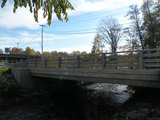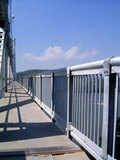Sodom Road
Recent 3 rail project. In the Town of Southeast New York.
Hutchinson River Parkway
4 rail bridge rail with modified pedestrian fencing
Corrugated Guide Rail
Corrugated guide rail can be a stand alone guide rail or bridge rail system that will terminate at each end. Or it can transition into box beam guide rail or a concrete parapet bridge.
Corrugated Guide Rail
Corrugated guide rail is the easiest guide rail to install. The rail is attached to W6 x 9 posts by one single bolt at each post and each section of rail is spliced together by a set of splice bolts.
Corrugated Guide Rail
Corrugated guide rail is usually used on low traffic volume roads and bridges. It is also the main guide rail system used all along the New York State Thruway.
Corrugated Guide Rail
A run of corrugated rail can be as short as one thirteen foot section (used in parking lots) or can run for miles like on the New York State Thruway.
Cable Guide Rail
At both ends of every run of cable guide rail the cable will be anchored to a concrete block that is buried in the ground.
Cable Guide Rail
Both the last post and the ends of the cable will anchor to the concrete block. Because of the way they are attached the post and the cables have the ability to break away from the concrete block to ensure that a vehicle is not hitting a fixed obstruction.
Cable Guide Rail
Cable guide rail consists of 3 runs of cable attached to posts. The purpose of the cable is to keep motor vehicles on the road and out of danger.
Cable Guide Rail
Every run of cable will have a spring compensator attached to it. These compensators will counteract for the added tension the cable will receive during a motor vehicle collision. The compensators are what keeps the cable from snapping.
Route 840 Extension
6 X 8 median barrier is guide rail that runs down the middle of the road seperating the two directions of traffic. It consists of a single run of 6 X 8 box beam sitting on top of the posts.
Route 840 Extension
Standard lengths for 6 X 8 median barrier are 18', 24', 30', and 36'. The median barrier can either be installed straight or it can be bent or mitre cut to any radius that you need to complete your project.
I87 North Exit 12
The most common guide rail in New York State is the 6 X 6 guide rail. It is a single run of 6 X 6 box beam that is used to guide motor vehicles away from a dangerous hazard if they were to leave the roadway.
I87 North Exit 12
After a bridge there is always a determined distance that a guide rail system must be implemented to protect traffic. In most cases 6 X 6 guide rail is used after a short transition section as shown in this picture.
Brockport - Holley Rd. Over Erie Canal
6 X 6 guide rail can also transition into other types of guide rail. Shown in the picture is a transition of 6 X 6 guide rail into W-Beam corrugated rail.
Route 291 Marcy, NY
When the road is straight then the 6 X 6 guide rail is also straight. The standard lengths that we stock are 36', 30', 24', and 18'. We can and will make custom lengths upon request.
Route 840 Extension
When the road curves then the 6 X 6 guide rail will curve with the bend of the road. 6 X 6 guide rail can be bent or mitre cut to any radius that might be needed to complete your project.
Route 840 Extension
When a run of 6 X 6 guide rail terminates it must do so safely. One way this is accomplished is by a drop end where the rail ends facing away from traffic at ground level. The other way is shown in this picture. It is known as a type 3 beat head system.
Genesee River Bridge Rochester, NY
5 rail bridge rail was used on this bridge to protect both pedestrians and cars from the edge of the bridge.
Genesee River Bridge Rochester, NY
This specific bridge rail system differs from a standard 5 rail system in two ways. First the bridge posts have a special bullett head top. Second the bridge does not transition into guide rail, instead it is capped on the end.
Genesee River Bridge Rochester, NY
Even with the addition of more rails there still remains just one rail that is not bolted directly to the post. On all rail systems the bottom run of 6 X 6 is bolted to a heavy clip angle.
Walkway Over The Hudson
Since this bridge was built for pedestrian travel only, aesthetics was a bigger factor in the design of the rail than functionality. Notice the combination of box beam and pipe with the picket fence system.
Walkway Over The Hudson
If you get a chance to travel to Poughkeepsie, NY take a walk over the Hudson River and take a look at our work. The bridge and scenery are a must see.
Route 291 Marcy, NY
3 rail bridge rail is the next step up from 2 rail. In addition to the 2 - 6 X 6 box beam runs that 2 rail bridges have there is a run of 5 X 3 X 1/4 box beam at the bottom.
Route 291 Marcy, NY
This picture shows the transition of a 3 rail bridge to guide rail. The bottom two rails of the bridge will terminate while the top rail attaches straight to the guide rail.
Brockport - Holley Rd. Over Erie Canal
4 rail bridge rail consists of 2 runs of 6 X 6 box beam with a run of 5 X 3 box beam both above and below the 6 X 6 runs.
Brockport - Holley Rd. Over Erie Canal
This bridge is an example of a standard 4 rail bridge with no brush curb and no snow fence.
Brockport - Holley Rd. Over Erie Canal
Each bridge post is anchored to the bridge and each piece of bridge rail is then fastened to each post on the bridge.
Brockport - Holley Rd. Over Erie Canal
In this picture you can see the standard transition of a 4 rail bridge into guide rail. Notice how the top 5 X 3 rail terminates with a kickdown while the bottom terminates with a flareback.
Middle Settlement Rd. Over 840 Extension
Here is another view of the transition of a 4 rail bridge. Notice how this is a non-standard design because it uses a flareback on the top rail instead of a kickdown.
Middle Settlement Rd. Over 840 Extension
This picture shows an example of a 4 rail bridge on a brush curb to allow for the sidewalk. This bridge also has a snow fence made possible by a larger base plate on the post and a piece of pipe.
Route 291 Marcy, NY
In this picture you can see the standard transition of 2 rail bridge rail into straight 6 X 6 guide rail.
Route 291 Marcy, NY
Bridge posts can be anchored straight to the bridge's steel beam or in concrete through the use of anchor studs. They can also be placed upon a brush curb or at the level of the road surface.
Route 291 Marcy, NY
Some bridges are constructed with snow fences attached to the bridge posts with a piece of pipe and a larger base plate.
Route 291 Marcy, NY
2 rail bridge rail is the simplest form of bridge rail. It consists of just two runs of 6 X 6 X 3/16 box beam.
Route 840 Extension
Cantilevers can come in either single arm or double arm styles. Seen in the picture is an example of a double arm. Cantilevers also come in different sizes according to the size of the sign to be mounted.
Route 840 Extension
The difference between cantilevers and spans is there is only one anchor point for cantilevers allowing them to overhang the road instead of spanning all of the traffic lanes.
Dunn Memorial Bridge
Both four span overhead sign structures located on Dunn Memorial Bridge over the Hudson River in Albany, NY
Dunn Memorial Bridge
Another view of the overhead sign structures in Albany, NY
Dunn Memorial Bridge
The trailer being towed below the sign structure gives great perspective on how large these structures really are
Dunn Memorial Bridge
View of the underside of an overhead sign structure. Notice the extensive angle support system used within the span.
Dunn Memorial Bridge
The span structures on this bridge came with a challenge. 99% of overhead sign structures are anchored to the ground. We had to fabricate special bridge mounts for anchoring. See the mounts in highway safety products
Sign Hanging System
Parts needed for hanging a traffic sign on an overhead sign structure can also be provided by Di Highway. Signs are produced by our sister company Hermosa Corporation. There is no need for any other suppliers!
Interstate 490
One of multiple sign structures produced for the NYSDOT in and around the city of Rochester, NY
Commercial Drive
4 section span over Commercial Drive in New Hartford, NY. This structure was one of multiple overhead sign structures produced for the 840 extension project.
Commercial Drive
View of the anchoring system for a standard span overhead sign structure. Notice how the end span section merely sits atop the end frame supports.
Route 840 Extension
Two small 2 section span structures located on the exit ramp of Route 840 in New Hartford, NY.
5 Rail Bridge Rail
5 Rail Bridge Rail is the most complex rail system of the simple bridges. It consists of two rungs of 6 X 6 Box Beam and three runs of 5 X 3 box beam.
Walkway Over The Hudson
Not all bridges are built for motor vehicle travel. Some bridges are built for pedestrians and non-motor vehicles. This bridge is a great example of that.
Walkway Over The Hudson
This custom bridge rail still uses the standard W6 X 25 I beam style bridge posts as a motor vehicle brridge. The posts then had custom fabricated sections of rail mounted to them.
Guide Rail Gallery
Choose a Gallery Below:








































































































































































